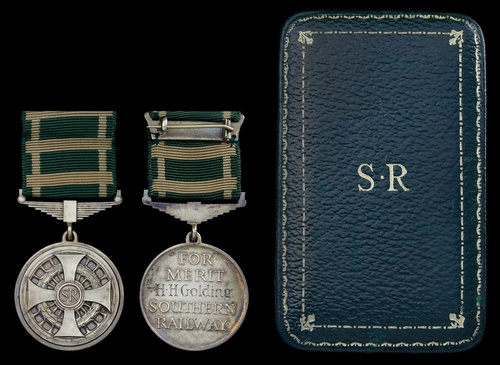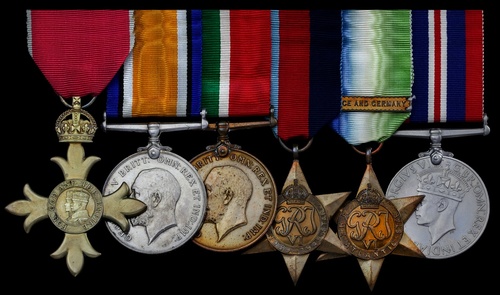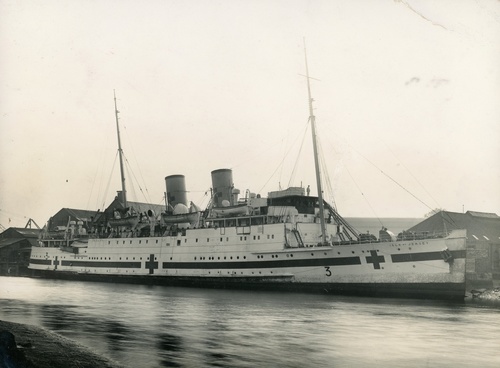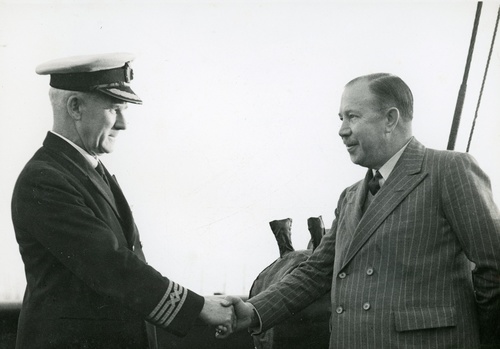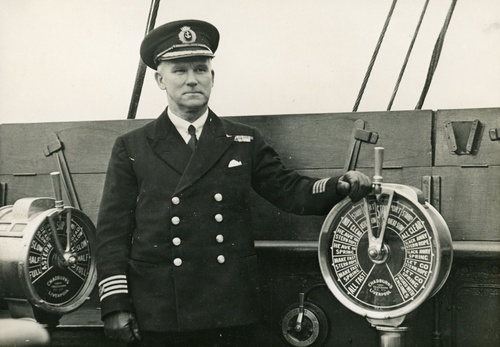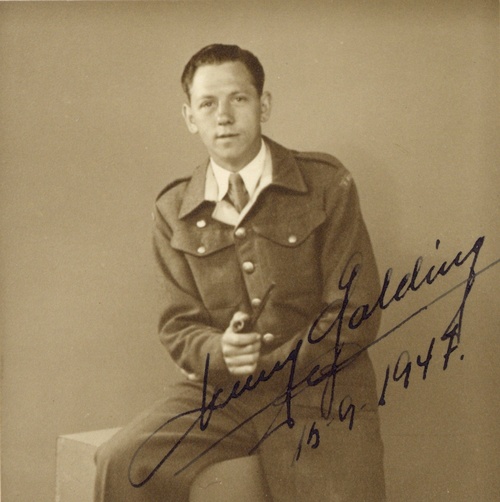Auction: 19003 - Orders, Decorations and Medals
Lot: 320
An extremely rare Second World War O.B.E. group of seven awarded to Captain H. H. Golding, Merchant Navy, one of a handful of recipients of the Southern Railway Company's M.S.M - for his gallant deeds as Master of the S.S. Isle of Sark in St. Peter Port, Guernsey in June 1940, when his ship came under attack while embarking evacuees
The Most Excellent Order of the British Empire, O.B.E. (Civil) Officer's 2nd type Breast Badge, silver-gilt, in its Royal Mint case of issue; British War Medal 1914-20 (Hervy H. Golding); Mercantile Marine War Medal 1914-18 (Hervy H. Golding); 1939-45 Star; Atlantic Star, clasp, France and Germany; War Medal 1939-45; Southern Railway Company's Meritorious Service Medal, silver-gilt, the reverse officially engraved, 'H. H. Golding', in its fitted Royal Mint case of issue, the Great War awards lightly polished, otherwise generally good very fine and better (7)
O.B.E. London Gazette 3 January 1945.
Southern Railway Company's M.S.M.:
'Delayed the departure of the S.S. Isle of Sark from Guernsey, during intense bombardment of the Island on 28 June 1940, in order that as many passengers as possible might be embarked.'
The Southern Railway Company's M.S.M. was instituted by the Company's directors soon after the outbreak of hostilities, 18 awards being presented at a ceremony held on 16 August 1940 and thereafter just six further awards.
Hervy Hardinge Golding was born in Tongham, near Farnham, Surrey in October 1887, and 'sailed out of Greenock as an apprentice aboard the Samoena, a three-masted ship, and for four years survived the life, sailing and the dreaded Southern Ocean, learning the skills that would one day enable him to join that exclusive society of men - the Cape Horners' (The Evening Echo, Bournemouth, 22 June 1974 refers).
Having passed his 2nd Mate's examination in London in November 1908 and his 1st Mate's examination in Hong Kong in November 1910, Golding was next employed in vessels of the British Steam Navigation Company and Seang Line, trading routes from Rangoon to China. In April 1914, he entered the service of the London & South Western Railway fleet as a 2nd Officer in the Bertha (afterwards merged with the London, Brighton & South Coast Railway, and the South Eastern & Chatham Railway companies to form the Southern Railway Company).
Actively employed in the Mercantile Marine in the Great War, he was employed on the Southampton-Le Havre run, latterly in the Normannia and Hantonnia. He stayed in the Company's employ for the remainder of his career, his otherwise peaceful voyages to France and the Channel Islands coming to an abrupt end on the renewal of hostilities.
The Evacuation of Guernsey - June 1940
On the renewal of hostilities, Golding was in command of the Isle of Jersey, shortly to be refitted as a hospital carrier, but in early 1940 he was given command of the Isle of Sark, which appointment led to his part in the evacuation of the Channel Islands. The ship's matter-of-fact official log entry for 28 June 1940 states:
'6.55 p.m., St. Peter Port, Guernsey: At time and place stated, while passengers were beginning to embark, enemy planes appeared and commenced a bombing and machine-gun action on harbour and shipping. A wireless transmission message was transmitted and acknowledged. The attack was maintained for an hour, during which no damage was done to the ship. Vessel sailed for Southampton at 10.15 p.m. according to schedule.'
A more extensive account of events that evening at St. Peter Port was later published in the Great Western Railway Magazine:
'On 28 June 1940 enemy bombers attacked in earnest. About 7 o'clock in the evening a number came over, flying at about 3,000 feet. Diving lower, they then machine-gunned the jetty and its vicinity, and bombed the harbour very intensely. As it was low tide, the area under the jetty provided reasonably good shelter for those who were able to get there, but casualties were nevertheless considerable. Three of the Company's staff were among the wounded who were taken to a hospital in the Island.
The jetty itself was soon ablaze with burning lorries, and at the end of the raid the scene was an inferno, and passage from any one point to another was not an easy matter. It is now clear to the Company's staff that it was high time to leave. There were three vessels in the harbour, which had been kept in steam in readiness for just such an emergency. They each had some guns for defensive action, and had succeeded in keeping hostile aircraft far enough away to prevent any direct hits. The vessels sailed for England at 9.30 p.m. the same evening, the Company's staff, as had already been stated, being on the last boat to leave. Of the 49 Great Western and Southern Railway joint staff at Guernsey, 38 sailed to England, three are known to have been left behind wounded, and eight remain unaccounted for. Most of the wives and families of the men had sailed for England at an earlier date. It is understood that the island of Guernsey was occupied by German troops on Sunday 30 June.'
And a glowing portrait of Golding's calmness under fire was later published in the Bournemouth Daily Echo, from which the following extract has been taken:
'The ship had some near misses and there were very heavy casualties among the people on the quay. A large number of lorries caught fire. The bombing and machine-gunning went on for about an hour. The quay was a shambles with 50 killed, 200 wounded and over 100 lorries burning.
Many of the women and children passengers were unaccompanied by men, and with the large number of people on the ship and on the quay a panic with grave consequences might easily have commenced.
Captain Golding issued orders from the bridge and then walked along the decks keeping everybody as calm as possible. His presence was felt immediately wherever he went, and in my judgment he was largely responsible for the steadiness of the crew, the passengers and the people on the quayside.
As soon as he felt the people aboard were steady, he walked across the quayside to telephone to the Naval Authorities, then returned calmly to his bridge, although concentrated machine-gunning and bombing were going on.
When the bombing had finished, he had to make important decisions. How many people he would take aboard from the number who were clamouring to come; the best time to leave in view of the fact that he would be unescorted and so on. It must also be remembered that he had a very tired crew. They had been working at top pressure for many weeks.
Captain Golding remained on duty the whole of the day as he had on every other day when in Guernsey. During the bombing and afterwards, he was absolutely calm and imperturbable, and tireless in stimulating and encouraging his crew.'
The Isle of Sark was in fact the final ship to depart St. Peter Port before the German occupation, with 647 passengers embarked, and but for the light A.A. and Lewis gun fire she put up at the attacking Heinkel IIIs, casualties may well have been higher. On Golding's recommendation, Able Seaman G. Mace, also received the Company's M.S.M. for manning the ship's gun on the same occasion.
Having been actively employed elsewhere, Golding was not able to attend the first investiture of the Company's M.S.M. in August 1940, but shortly afterwards he received his award at Southampton from the 'Docks and Port Manager, in the presence of many officials and staff - the gathering also included the Flag Officer i./c. Naval Operations, Southampton, the Garrison Commander and the Principal Sea Transport Officer' (Southern Railway's Journal, refers).
Golding returned to his old command, the Isle of Jersey, in December 1940, by now a fully fitted-out hospital carrier attached to the Home Fleet at Scapa Flow and in which capacity he remained in command until the War's end. During the Normandy landings, the Isle of Jersey steamed south and served off Gold and Juno Beaches, bringing home nearly 2000 patients in a matter of weeks. He was awarded the O.B.E. and returned in triumph to St. Peter Port in October 1945.
Golding finally retired in late 1947, after 33 years with the Southern Railway Fleet, latterly having served as Commodore of the company's Southampton Section - and having completed 4,800 Channel crossings. He died in December 1982, aged 94 years.
To be sold with the following impressive archive of related memorabilia:
(i)
Documentation:
Ordinary Apprentice's Certificate of Indenture, dated 9 September 1904, for 4 years to the John Clink Line at Greenock.
A privately compiled ship's log covering the recipient's time in the Samoena circa 1906-08, large cloth bound volume with leather spine.
A quantity of competency reports (or "Flimsies") in respect of the recipient's pre-Great War service out in the Far East in ships of the British Steam Navigation Company and Seang Line, circa 1910-13, together with a run of related discharge certificates.
Certificate of Competency as Master of a Foreign Going Ship, Board of Trade, dated 18 July 1913.
Board of Trade correspondence relating to the award of the recipient's British War and Mercantile Marine Medals 1914-18, including forwarding letter dated 4 May 1921; together with Ministry of Transport forwarding certificate for his 1939-45 campaign awards.
A series of privately compiled ship log books (15), with details of individual voyages, many with Southern Railway label to front cover bearing the recipient's name and relevant dates, and covering the periods January 1918 to December 1922; January 1923 to December 1928; 22 June 1927 to 31 August 1929; 2 September 1929 to 23 October 1930; 23 October 1930 to 2 July 1932; 4 July 1932 to 29 May 1934; 29 May 1934 to 3 August 1935; 3 August 1935 to 22 July 1936; 23 July 1936 to 9 August 1937; 10 August 1937 to 11 June 1939 (re. Isle of Jersey); January 1939 to December 1936; 3 November 1937 to 15 April 1939; 12 June 1939 to July 1946; a separate folder entitled Isle of Jersey - Account of All Movements 24 August 1939 to 11 July 1945; 20 July 1946 to 11 September 1947; and another up to September 1947, but with earlier entries from January 1937; together with Golding's Guernsey and Jersey Pilot's log books and notes.
Golding's official Dock Permit (No. 21067), for permission to enter Southern Railway Company's docks at Southampton, dated 8 May 1940; and three letters of appreciation from passengers he brought out of St. Peter Port a few weeks later, citing his calmness under fire and the steady conduct of his crew.
A fascinating scrap album, with numerous newspaper reports, many dealing with events at St. Peter's Port in June 1940, together with some official reports and correspondence, the latter including a letter from the Manager of Southern Railway congratulating Golding on his courage and resource, and Ministry of War Transport letter of notification regarding the award of his O.B.E.
The recipient's original O.B.E. warrant, dated 1 January 1945, framed and glazed.
The recipient's Imperial Merchant Service Guild membership certificate, brown leather folder with gilt title.
His Minister of Shipping Continuous Certificate of Discharge (R218098).
A hand-illuminated retirement certificate, the upper inscription reading, 'We the undersigned Ships Officers of the Marine Department of the Southern Railway at Southampton hereby place on record our esteem and good wishes to Captain H. H. Golding, O.B.E., on his retirement from the service after 43 years at sea and wish him a long and happy enjoyment of his well earned rest', with 50 signatures (some faded), 30cm. by 26cm., framed; together with an assortment of related retirement telegrams and letters.
A box containing as large quantity of "Cape Horners" documentation, membership and otherwise.
A file containing assorted letters of condolence and cards (approximately 25); and much further documentation, including pocket diaries, marriage certificate, wills, insurance policies and further family-related papers.
(ii)
Photographs:
An image of the Officers and Apprentices of the Samoena, circa 1907, 37cm. by 32cm., framed and glazed; another from same period, or slightly later, by local photographer Chueng Kulan, Amoy, 43cm. by 36cm., framed and glazed; and a pair of smaller group images from his days in the Glengogle in the Far East, both framed; an image of the Isle of Jersey, the mount captioned, 'H.M. Hospital Ship "Isle of Jersey". Refitted by The Grangemouth Dockyard Co. Ltd, October 1941', 30.5cm. by 25cm., framed and glazed; a display of 14 wartime images, mainly of Isle of Jersey interest, framed and glazed, and two further images of Golding, his ship's officers and matrons from the same period, framed and glazed.
Photograph albums (8), with several hundred images in total, covering his time in the Far East, 1911-13, with excellent ship views and captioned crew images; inter-war service and various "family" travel and holiday scenes in the U.K. and abroad, together with a postcard album.
A large selection of other photographs, dating from the late Victorian era through to the 1950s (approximately 400 images), quite a few on card mounts, many of nautical interest but others of family subject matter, the former including numerous scenes from the Isle of Jersey in the 1939-45 War.
(iii)
Pictures:
A watercolour of 'H.M.H.C. "Isle of Jersey" at sea', initialled 'J. D. A.' and dated 1945, 30.5cm. by 20cm., framed and glazed.
A water colour depicting a ship in distress approaching rocks, unsigned, 19cm. by 13.5cm., framed and glazed.
(iv)
Nautical Memorabilia:
Captain Golding's sea chest, the exterior green painted, the plain wooden interior with two large and one smaller raised compartments, and the inside of the lid with hand-painted signal flags, rope handles, 87cm. by 43cm. by 39cm.
A portable ship's compass, by Mahier, Le Havre, in wooden, part-glazed carrying case.
A telescope, by Ross, London (No. 47449), retailed by Murray, Calcutta, leather grip.
Captain Field's improved parallel rule, antique boxwood, brass hinges; together with a whistle, pocket compass and stop-watch.
A selection of ship's pennants and flags (5), including large yellow flag emblazoned with an Imperial Chinese dragon, this latter, as described in an accompanying newspaper article, 'flown from the foremast of his last deep sea command, plying the China Seas and visiting ports all over the Far East'.
A portable signal kit, by Woolf, Southampton, with individual pockets containing 20 pennants, and lower pockets for burgee, signal book and ensign, the whole contained in a folding brown canvas case, with ties; together with a smaller kit of nine pennants in a white linen container.
A selection of items relevant to the "Cape Horners", including brass and enamelled car bumper badge, a glass ashtray, two blazer patches and two lapel badges; Merchant Navy "MN" lapel badge and two similar tie-pins; the recipient's silver identity bracelet, inscribed 'ENN221818 H. H. Golding, Ewshott, Brockenhurst', together with his bullion embroidered cap badge, three similar company badges, and a large quantity of Merchant Navy uniform buttons.
A bag containing several expended .303 shell cases and a piece of shrapnel, these latter souvenirs of events at St. Peter Port in 1940.
A bullion and embroidered uniform epaulette of Queen Alexandra's Royal Naval Nursing Service, mounted on card, with "H.M.H.C. Isle of Jersey" inscribed above, and accompanied by five signatures of nursing staff who served in her, dated 1944-45, framed and glazed.
A presentation silver salver, hallmarks for Birmingham 1940, with central inscription, 'To the Captain, September 1947', with ten engraved autographs around, 24.5cm.
Subject to 20% VAT on Buyer’s Premium. For more information please view Terms and Conditions for Buyers.
Estimate
£5,000 to £6,000
Starting price
£3200

